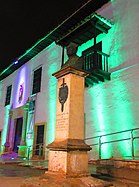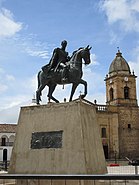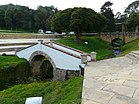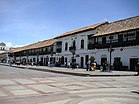
Back تونخا Arabic Tunja AVK Tunxa Azerbaijani Тунха Bulgarian Tunja Catalan Tunja (munisipyo) CEB Tunja Czech Tunja German Tunja DIQ Τούνχα Greek
Tunja | |
|---|---|
Municipality and city | |
From the top: Main Cathedral, Bust of Juan de Castellanos in the Plaza de Bolívar de Tunja, Statue of Simon Bolivar in the main square, Bridge of Boyacá, Tunja Central Square and Panoramic from the north. | |
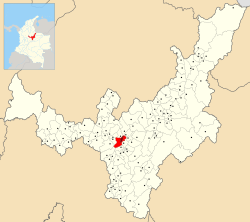 Location of Tunja in the department of Boyacá | |
| Coordinates: 5°32′N 73°22′W / 5.533°N 73.367°W | |
| Country | Colombia |
| Department | Boyacá |
| Province | Central Boyacá Province |
| Founded | 6 August 1539 (485 Years ago) |
| Established | March 29, 1541 |
| Founded by | Gonzalo Suárez Rendón |
| Government | |
| • Mayor | Mikhail Krasnov (2024-2027) |
| Area | |
| • Municipality and city | 119.7 km2 (46.2 sq mi) |
| • Urban | 21.51 km2 (8.31 sq mi) |
| Elevation | 2,820 m (9,250 ft) |
| Population (2018 census)[1] | |
| • Municipality and city | 172,548 |
| • Density | 1,400/km2 (3,700/sq mi) |
| • Urban | 163,894 |
| • Urban density | 7,600/km2 (20,000/sq mi) |
| • Metro | 243,330 |
| Demonym | Tunjano |
| Postal code | 150001-150009 |
| Area code | 57 + 8 |
| Website | http://www.tunja-boyaca.gov.co - https://www.tunjaculturayturismo.gov.co/inicio/ |
| IGAC - DANE - DIAN. | |
 |
| Part of a series on |
| Muisca culture |
|---|
| Topics |
| Geography |
| The Salt People |
| Main neighbours |
| History and timeline |
Tunja (Spanish pronunciation: [ˈtuŋxa]) is a municipality and city on the Eastern Ranges of the Colombian Andes, in the region known as the Altiplano Cundiboyacense, 130 km northeast of Bogotá. In 2018 the municipality had a population of 172,548.[1] It is the capital of Boyacá department and the Central Boyacá Province. Tunja is an important educational centre of well-known universities. In the time before the Spanish conquest of the Muisca, there was an indigenous settlement, called Hunza, seat of the hoa Eucaneme, conquered by the Spanish conquistadors on August 20, 1537. The Spanish city was founded by captain Gonzalo Suárez Rendón on August 6, 1539, exactly one year after the capital Santafé de Bogotá. The city hosts the most remaining Muisca architecture: Hunzahúa Well, Goranchacha Temple and Cojines del Zaque.
Tunja is a tourist destination, especially for religious colonial architecture, with the Casa Fundador Gonzalo Suárez Rendón as oldest remnant.[2] In addition to its religious and historical sites it is host to several internationally known festivals and is a jumping-off point for regional tourist destinations such as Villa de Leyva, Paipa, and Sierra Nevada del Cocuy. It is a stop on the Pan American Highway which connects Tunja to Bogotá and Santa Marta and eventually to the northern and southernmost parts of South America.
- ^ a b Infomacion Capital (in Spanish) Retrieved November 17, 2022
- ^ (in Spanish) El Turismo: fuerza económica de Boyacá
© MMXXIII Rich X Search. We shall prevail. All rights reserved. Rich X Search

